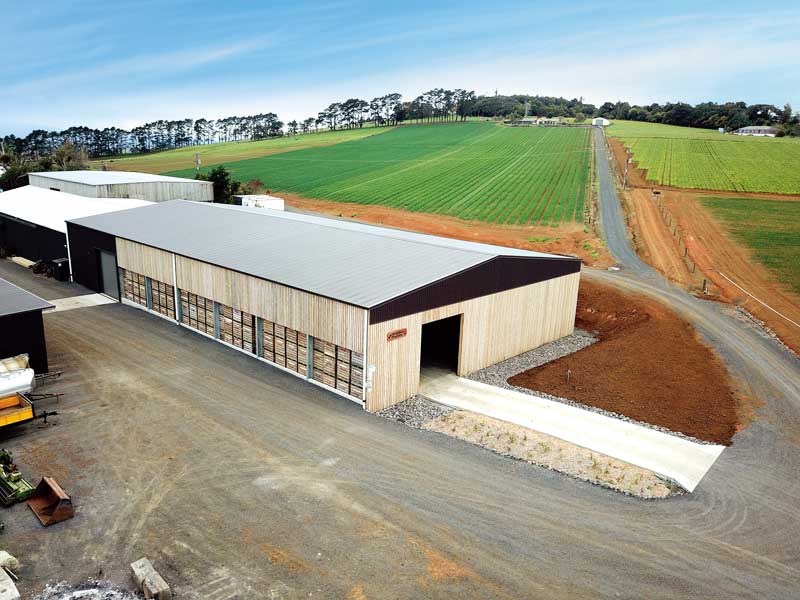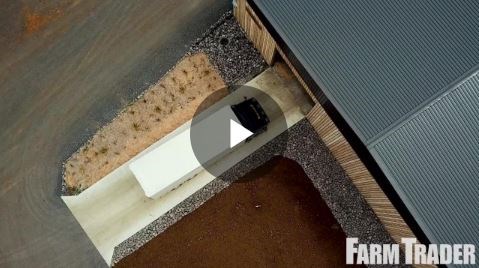Cover Story: Alpine Buildings
 The 1350m squared open-sided building has been designed as a sizeable storage shed for produce bins
The 1350m squared open-sided building has been designed as a sizeable storage shed for produce bins

 The new building adjoins an existing shed, which is the main packhouse
The new building adjoins an existing shed, which is the main packhouse

 Bins are arranged with precise spacing between to help with airflow and placement or retrieval
Bins are arranged with precise spacing between to help with airflow and placement or retrieval

 This state-of-the-art palletiser makes the Hinemoa team’s packing and distribution work much easier
This state-of-the-art palletiser makes the Hinemoa team’s packing and distribution work much easier

 Galvanised steel protects the shed structure from the elements
Galvanised steel protects the shed structure from the elements

 Hinemoa Quality Producers sell potatoes and onions to a variety of household name brands
Hinemoa Quality Producers sell potatoes and onions to a variety of household name brands


|
|
The 1350m squared open-sided building has been designed as a sizeable storage shed for produce bins
|

|
|
The new building adjoins an existing shed, which is the main packhouse
|

|
|
Bins are arranged with precise spacing between to help with airflow and placement or retrieval
|

|
|
This state-of-the-art palletiser makes the Hinemoa team’s packing and distribution work much easier
|

|
|
Galvanised steel protects the shed structure from the elements
|

|
|
Hinemoa Quality Producers sell potatoes and onions to a variety of household name brands
|
Planning a shed? Farm Trader profiles a recent Alpine Buildings creation.
There’s that old saying, ‘Build it and they will come.’ In this particular case, ‘they’ won’t be birds, though. Chris Nicholson from Hinemoa Quality Producers has thoroughly mitigated that issue, thanks to some clever design features engineered into the latest build on his property.
The new structure is getting plenty of attention (generally from humans) and has certainly created a new focal point as you approach Chris’ family business up a long driveway in Pukekawa District, south of Tuakau.
 |
|
Chris Nicholson
|
The 1350m² open-sided shed is an Alpine Buildings design. At just 10 months old and compared to the last shed built on the property – in 1993 – the structure is brand-spanking and features plenty of architectural and material advances.
Chris needed a big shed in order to be able to store more than 2000 produce bins, which will soon be full of potatoes and onions; he and his team will harvest 3000 tonnes of each by the peak of the season. The new shed adjoins an older building that is still used as a packhouse (albeit outfitted with some clever high-tech palletising machinery).
Space race
 |
|
The Alpine Buildings shed is the first structure visitors to Hinemoa Quality Psvroducers see when they arrive
|
Things have changed a bit since Chris’ grandfather established a sheep and beef farm on the property at the end of World War II. Cropping became the chief focus in the late-1970s and, while today, around 60 steers are grazed on the run-off areas, the old cattle yards have gone, replaced by the new Alpine Buildings shed out of necessity.
"We needed the extra storage space in order to work more efficiently," Chris explains. "Previously, we’d need to begin each day by transferring and stacking bins out in the yard before other processing could happen. Now we’ve got a purpose-built area for bin storage that will suit the needs of our output for several years to come.
 |
|
Such is the size of the shed it appears to swallow large trucks whole
|
"In fact, we designed the shed to be around 30 metres larger than what we probably need it to be, but that’s simply to ensure the operation is future-proofed to a degree.
"We’re harvesting and processing large amounts of produce here, so we need to make sure the workflow is consistent. Obviously, machinery plays a big part in that but so does our storage infrastructure."
Roots to rafters
 |
|
Around 60% of the company’s onions are exported
|
A familiar livery around Counties Manukau and beyond, Hinemoa Quality Producers run a 150-hectare mix of onions and potatoes, with the balance of the property seeded with lucerne and barley, which is sold as feedlots. Chris says a strict rotation of two-yearly cycles for onions, then lucerne, then potatoes helps with ground conditioning.
The company counts plenty of big names among its client base, including Turners & Growers, Bluebird, and the PakNSave supermarket group. Sixty percent of Hinemoa’s onion crop is exported to the Pacific.
In designing the layout of the new building, Chris says form had to follow function, with air flow being of paramount consideration.
"Although today it’s relatively empty, in February it will be full," he says. "It has been designed so that each row of bins has a six-inch gap between them, and then there is a four-inch gap between each stack.
 |
|
Manoeuvering trucks and other machinery around inside the shed is easy
|
We’ve allowed for enough room to manoeuver trucks and other machinery around inside, even when it is much fuller than you see it today. You really don’t realise how large it is until you park a big truck in there and look at the space around it.
"That’s where Alpine Buildings’ design work really comes into its own. In opening up the interior and not having any support poles interrupting floor space, it allows us to make our machine movements quicker and make more use of the available space."
Built to last
 |
|
Alpine Buildings’ Zero-Bird-Perch rafter system cleverly mitigates nesting or roosting spots
|
Chris says a wide span and high ceiling height to allow for greater bin volume were key attributes for him. Alpine Buildings worked with him in order to assess what would be needed.
"I think Alpine Buildings has designed wider and longer sheds than this in the past, but the structure goes from seven metres at the sides up to 10.9 metres at the roof peak, which is pretty high. They were excellent at advising us on all the options, though; they’re the masters at constructing large-scale buildings, so we trusted their opinion."
The Alpine structural design proved ideal for Chris’ needs, with the company’s Clearspan template mitigating the need for centre poles. Alpine Buildings says that most of its clients can fit up to 50% more equipment or produce inside their buildings.
As already mentioned, and equally handy for Chris, is Alpine Buildings’ Zero-Bird-Perch rafter design, which eliminates nooks where birds might nest, or at least take what polite society would call a ‘rest stop’. The special ‘slot and bolt’ design makes for a flush surface.
Rafters are constructed from hot-dip galvanised steel, which, the company says, is 2.5 times better than any other steel protection coating available. The comprehensive molten zinc coating gives much better overall coverage inside and out rather than zinc spray, which only protects the outside surface of the rafter. That makes for better long-term rust protection and less maintenance.
 |
|
Don’t be fooled: that’s not a wall, those are stacks of produce bins
|
So, if it’s future-proofing Chris was after, he has certainly got it. A further bonus to the crops Chris will be placing inside the new shed during harvest is the building’s timber frame construction, which allows for better temperature control and doesn’t ‘sweat’ like an all-steel shed. Of course, the side-less design means this is a given, but condensation dripping down from above has also been eradicated.
The front of the building features drainage sumps built to specification to perform in a one-hundred-year flood event. The attractive slat wood finish (full length at the front of the building, one-third at the sides) was a feature of Chris’ own design, though – "Just to give it a bit of character," he laughs.
It certainly looks great, accentuating the timber construction of the remainder of the structure and creating plenty of impact as the first building visitors to the company’s property see when they arrive.
 |
|
The attractive slat finish was an idea of Chris Nicholson’s to give the shed a bit of impact
|
"You don’t build a new shed like this every year. When you do it, you have to do it right so that it works for you for a long time to come," Chris says."I think a combination of the footprint of the shed, the material it is constructed from, and the fact that Alpine Buildings stand behind the strength and endurance of their sheds means it has been a very successful project.
"Now we just have to have a good harvest and fill it full of produce," he smiles. So maybe that saying should be something more along the lines of ‘Build it and the crops will come’? Here’s hoping.
Video: Alpine Buildings
Click below to watch the video
Keep up to date in the industry by signing up to Farm Trader's free newsletter or liking us on Facebook



.jpeg)
.jpg)
.jpeg)

.jpg)
.jpeg)
.jpg)
.jpeg)







